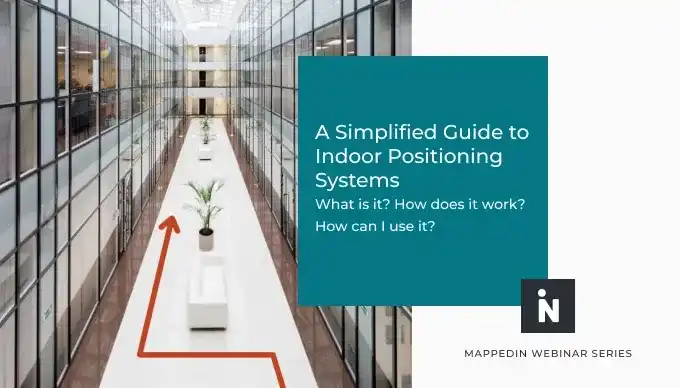Indoor mapping makes indoor spaces and venues discoverable by enabling solutions such as indoor positioning and indoor navigation. While both technologies help you find your way around indoor spaces, each provides its own unique benefits. Today we will discuss how they work, how they differ, and how to leverage them to unlock powerful navigation experiences.
What is indoor navigation?
Indoor navigation systems provide users with spatial context of a venue and intuitive directions. This can include 2D printed maps or large “you are here” signage but often in today’s world, indoor navigation systems can take the form of a digital and interactive display. Indoor navigation systems can be used across mobile, tablet, web, or directory devices. A user can select or search for any point of interest on a 3D digital map and receive turn-by-turn directions to their desired destination. If you're interested in learning more about how this works for your particular use case, contact us.

Indoor maps and navigation
To create an indoor navigation experience, you need an indoor map. With more than a decade of experience in the indoor mapping industry, Mappedin is the ideal platform for your digital wayfinding and navigation needs. Mappedin offers incredible pre-built solutions that have customer maps up-and-running quickly, as well as SDKs and developer tools for customers that want to create custom indoor maps or integrate additional location-based experiences. Our solutions enable users to search, discover, and navigate complex indoor venues with ease.
How does an indoor navigation system work?
An effective indoor navigation system relies on an accurate digital map to operate seamlessly. Pathing is implemented into 3D digital maps to populate the most efficient routes. After implementing pathing (the routes that users need to navigate a space) and creating an indoor navigation system, a user can define start and end points of interest and begin single/multi-floor navigation with turn-by-turn directions from any predefined location on the map. A user can take advantage of an indoor navigation system by accessing maps from a website, mobile application, or digital directories placed in key areas of a venue.

Benefits of indoor navigation
Indoor navigation elevates your indoor mapping experience. Large venues with many amenities like campuses, hospitals, stadiums, amusement parks, and malls can be difficult to navigate. An indoor navigation system makes finding places easier with accurate and real-time directions. Students can save time when planning their trip to class, hospital visitors can locate the room of a patient they are visiting, fans can find their seat in a stadium, shoppers can save time wandering around the mall, and more.
What is indoor positioning?
An indoor positioning system (IPS) can be thought of as a global positioning system (GPS) for indoor venues. While GPS is used outdoors, IPS can detect real-time locations to accurately determine the coordinates of people or assets inside a building. These coordinates are typically represented visually by a blue dot on a digital indoor map to provide additional context to users and features such as wayfinding.

If you're looking for a specific location for example, you can pull up the digital mall map on your mobile device and get directions from your exact location. Similar to outdoor GPS, users are not required to enter a "start" destination and as they begin to follow along a route, the blue dot moves with them.
How does an indoor positioning system work?
When trying to navigate indoors, often leveraging a GPS signal is out of the question as buildings limit access to GPS signals. With the absence of a GPS signal, devices must rely on other technologies such as indoor positioning to pinpoint the indoor location of a user. There are a variety of indoor positioning technologies that can be used, including beacons, Wi-Fi, RFID, and geomagnetic.
Whether leveraging a cost-effective infrastructure-free system, or a more accurate hardware system, these technologies can enable a user to locate themselves or enable employees to keep track of their assets within a building.
Different types of indoor positioning systems
Infrastructure-free systems
An infrastructure-free indoor positioning system is a cost-effective solution as it exclusively leverages a user’s on-site device to obtain their indoor position. Wi-Fi-based systems use radio frequency patterns from Wi-Fi access points to locate a device’s precise location.
Proximity-based systems like geofencing leverage Wi-Fi and cellular signals to track on-site devices. Geofencing helps determine geographic areas and boundaries, and relies on physical location information to set up a geofence trigger. When a device enters the geofenced area, an alert or notification is issued.

Another alternative to indoor positioning hardware is Apple’s infrastructure-free indoor positioning. Mappedin uses the method of “fingerprinting” through Apple’s Indoor Survey app to generate the blue dot experience. The best part about this feature is that it’s directly integrated into both Mappedin SDK and pre-built applications and, with the Mappedin Responsive Web App, visitors can get the blue dot experience directly through a web browser.
Hardware systems
Hardware systems require the physical implementation of sensors within a venue. These hardware systems enhance Wi-Fi-based location systems but require maintenance and setup costs. When looking to implement hardware systems to enhance accuracy, sensors can be added to transmit Wi-Fi, Bluetooth Low Energy, and cellular signals. Some of these sensors are called “beacons” and are strategically placed throughout indoor environments to detect mobile devices or RFID tags. Most beacons are considered one-way transmitters, always on, and continuously transmit signals to be detected.
The benefits of indoor positioning
Along with enabling users to accurately visualize their real-time position within a venue, an indoor positioning solution can provide additional benefits. As discussed in our How to Use Indoor Positioning Analytics to Benefit Your Business blog, companies can use indoor positioning data and analytics to identify potential areas for investment, analyze areas of high (or low) foot traffic with heat maps, or can implement proximity marketing to target customers with personalized deals and promotions.

Companies can implement asset tracking to locate the exact positioning of personnel, assets, and vehicle movements in real-time. Indoor positioning can also be used for contract tracing to help create safer workplace environments. On top of that, by enabling wayfinding, asset tracking, and contact monitoring through IPS, buildings can create a network of connected devices and experiences. Regardless of the use case, indoor positioning systems can create new efficiencies and experiences.
What is the difference between indoor positioning and indoor navigation?
The main difference between indoor positioning and indoor navigation is that they are two different technologies that work together to create a seamless wayfinding experience for users. Indoor positioning systems can pinpoint a user’s location without having to input a "start" destination, and if a user strays from their path, the navigation will update automatically to guide them back on course. The indoor navigation system provides users with spatial context and turn-by-turn directions inside a building. Paired together, these technologies help users find their way around indoor locations with ease.
One example of this is follow-mode which uses both indoor positioning and indoor navigation. Follow mode leverages a user’s position throughout their journey as they follow directions provided by the indoor navigation system. A blue dot will signal a user’s current indoor location and the dot will follow them as they navigate their way through an indoor venue. This provides further context to users and enables them to digitally visualize their journey through the building.
Contact us today to find out how you can create a powerful indoor navigation experience for your venue.
Tagged In
Share


